한국 풍류의 멋을 관조하는 한국에서 살아가는 세계인 – 베르너 사세Werner Sasse
Contemplating the beauty of Korean Pungnyu, A global citizen living in Korea - Werner Sasse
Localler
새롭게 떠오르는 문화를 발견해 융합해 나가는 ‘문화의 선구자 Culture Vanguard’ 역시 기아 디자인 크리에이티브 철학의 문화적 특징 중 하나입니다. 기아디자인매거진은 Localler라는 메뉴를 통해 ‘문화의 선구자 Culture Vanguard’라는 타이틀로 한국에서 살고 있는 현지 외국인, 외국에서 살고 있는 현지 한국인들의 경계 없는 스토리를 보여줍니다.
Localler
Culture Vanguard, who discovers and integrates emerging cultures, is another cultural feature of Kia Design’s creative philosophy. Kia Design Magazine presents the stories of foreigners living in Korea, local Koreans living abroad, and local Koreans living in foreign countries under the title of “Culture Vanguard” through the Localler menu.
산일까? 바위일까? 혹은 사람일까? 추상적인 수묵화를 바라보고 있자면 머릿속에서 상상의 나래가 펼쳐진다. 베르너 사세는 자신이 그려낸 작품에는 제목이 없다고 말한다. ‘무제(無題)’이기 때문에 하루는 산이 될 수도 있고, 또 다른 하루는 바위 혹은 사람이 될 수도 있다. “한지 위에 먹이 노니는 데로 그림을 그려 나갑니다. 그래서 제목이 없어요. 관람객들도 제목이 있으면 한정된 시각으로 바라보게 되죠.” 한국과 50년 가까이 인연을 맺어오고 있는 독일인 한국학자이자 수묵화가 베르너 사세Werner Sasse가 생각하는 문화예술은 ‘정해진 답이 없는 것’이라고 생각하기 때문. 한지에 스며드는 먹처럼 한국이란 나라에 서서히 스며든 베르너 사세에게 우리가 미처 놓쳤던 한국의 이야기를 들어보았다.
Is it a mountain? A rock? Or a person? When looking at abstract Ink Paintings(Sumukwa), the imagination unfolds in the mind. Werner Sasse says that his works have no titles. Because they are untitled, one day it could be a mountain, and the next day it could be a rock or a person. “I draw pictures as the ink runs on the hanji. That’s why there is no title. If there is a title, visitors will look at it from a limited perspective.” This is because the German Korean scholar and ink painter Werner Sasse, who has been connected to Korea for nearly 50 years, believes that culture and art are things that have no set answers. We listened to the story of Korea that Werner Sasse, who has slowly been absorbed into the country like the ink that soaks into hanji, has missed.
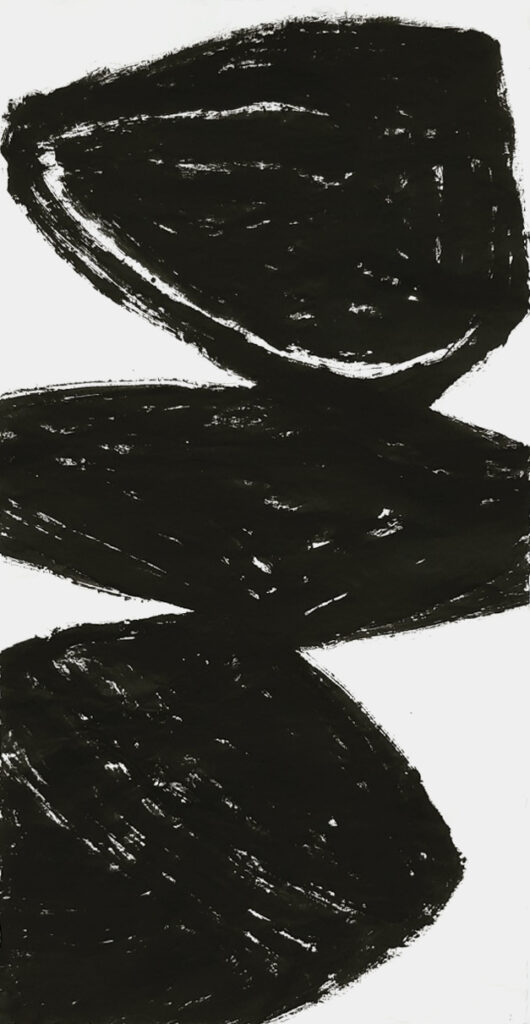
1966년, 전남 나주에 푸른 눈의 한 남자가 도착했다. 그에게 비친 한국의 풍경은 생경했지만 이전에 본 적 없었기에 매력적으로 다가왔다. 서양식 주택과는 다른 한옥이, 논두렁에서 일을 하다 술 한잔 걸치곤 툭하고 내뱉는 노인의 노래(시조) 등이. 그렇게 한국이란 나라에 점차 스며든 그 사람은 바로 독일인 베르너 사세다. 비료공장에 기술고문으로 부임한 장인을 따라 한국에서 생활하게 된 그는 기술고등학교 강사로 일하며 한국 문화에 관심을 갖게 되었다.
1960년 개발이 막 시작된 한국이었지만 지방은 그때 까지만 해도 농경사회를 유지하고 있었다. 이 때문에 전통의 흔적을 쉬이 찾아볼 수 있었던 것. 한옥과 막걸리, 새참, 창과 시조 등은 베르너 사세에게는 매력적인 한국의 모습으로 다가올 수밖에 없었다. 당시 그는 한국어를 공부한 적도 없었을뿐더러 한국이란 나라에 대해 아는 것이 전무했기 때문. 그렇게 우연한 기회에 한국과 연을 맺은 그는 4년 후 다시 독일로 돌아가 한국학을 공부하기 시작하며 독일인 최초 한국학자가 되었다. 2007년 한국 대학교에 교수로 초빙되어 한국으로 돌아온 그는 한국인보다 한국학을 열정적으로 파고들며, 한국 전통 수묵화를 그리는 화가로 살아가고 있다. 《기아 디자인 매거진》은 그에게 “우리도 모르는 한국의 이야기를, 화선지에 담고 싶은 한국은 무엇인지”를 물었다.
In 1966, a man with blue eyes arrived in Naju, South Jeolla Province. The scenery of Korea that he saw was unfamiliar, but it was attractive because he had never seen it before. Hanok, which is different from Western-style houses, and the songs (si-jo) of old men who work on the ridges of rice paddies and then drink a glass of soju. That person who gradually penetrated into the country of Korea was Werner Sasse, a German. He came to live in Korea after following his master, who had been appointed as a technical advisor to a fertilizer plant and became interested in Korean culture while working as a lecturer at a technical high school.
In 1960, when Korea was just beginning to develop, the provinces were still maintaining an agrarian society. This is why traces of tradition could be easily found. Hanok, makgeolli(Traditional liquor), Saechim*(meal),Traditional songs and poems were all attractive aspects of Korea for Werner Sasse. This was because he had never studied Korean and knew nothing about the country. He became connected with Korea by such a chance, and four years later he returned to Germany to study Korean studies and became the first German scholar of Korean studies. After returning to Korea in 2007 as a professor at a Korean university, he has been more passionate about Korean studies than Koreans and is living as a painter who paints traditional Korean ink paintings. Kia Design Magazine asked him, “What is Korea that you want to put on the paper of Korean stories that we don’t even know?”
*Saecham
Food eaten while taking a short break from work.
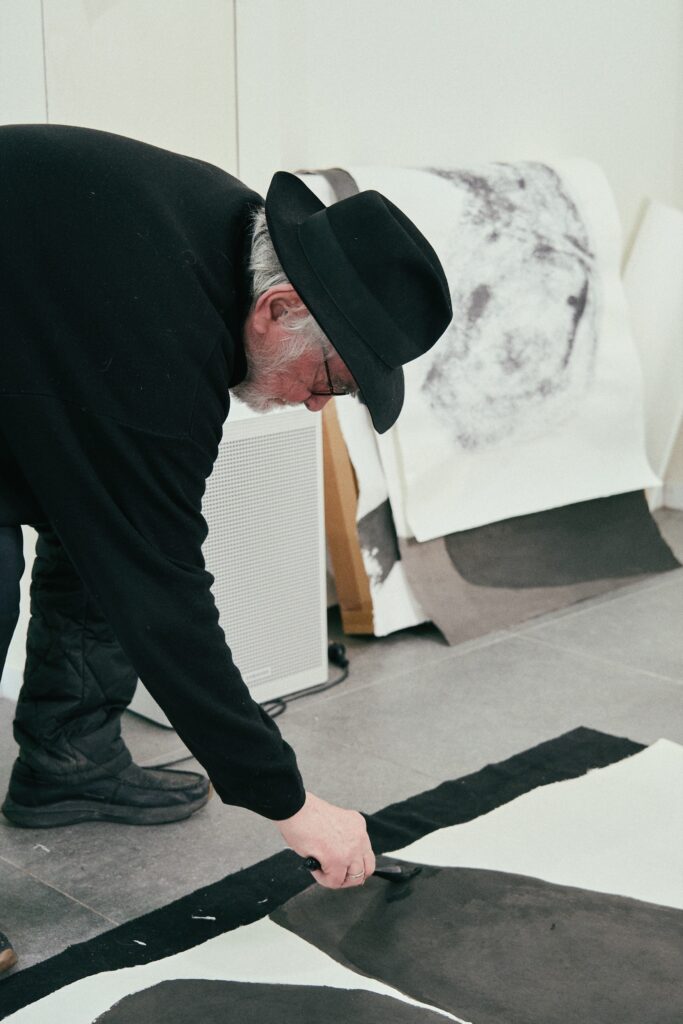
#한국
본질이 아름다운 코리아
#Korea
Korea, a country with a beautiful essence
독일로 돌아간 베르너 사세의 머릿속에 한국에서의 생활이 계속해서 둥둥 떠다녔다. 청년 베르너 사세에게는 한국은 미지의 세계였고, 낯설었지만, 이상하게 알고 싶어졌다. 당시 한국의 생활은 어려웠지만 여유롭게 창가와 시조를 읊는 한국인들의 모습이 색다르게 다가온 것이다. 독일로 돌아간 그는 한글을 배우기 시작했다. 하지만 상황이 여의치 않았다.
“1970년대에 당시 독일에는 한국학과가 없었어요. 그래서 저는 동아시아를 가르치는 일본, 중국 등의 문화와 언어를 배우면서 한국어에 파고들었어요. 에둘러 한국어를 배우기 시작했던 거죠.”
하지만 그의 집념은 최초의 한국학 박사학위라는 타이틀을 그에게 안겨주었다. 박사 학위 논문은 ‘계림유사에 나타난 고려방언’. 한국 사람도 낯설게 느껴질 ‘고려방언’이라니 새삼 놀라지 않을 수 없다.
“한국어를 알타이어*라고 말하는 분들도 있지만 거리상 알타이어와 가깝지 않다고 생각해요. 저는 한국어의 뿌리를 고려방언에서 찾았지요.”
*알타이어
알타이어는 동아시아에서 유럽 동부에 이르는 여러 어족들을 묶어서 가리키는 개념. 언어학계 일각에서는 튀르크어족, 퉁구스어족, 몽골어족 및 계통이 불분명한 일본어족, 한국어족 등이 하나의 거대한 어족에 속함
The life in Korea continued to float in Werner Sasse’s mind as he returned to Germany. Korea was an unknown world to the young Werner Sasse, and although it was unfamiliar, he strangely wanted to know more about it. Although life in Korea was difficult at the time, the sight of Koreans leisurely reciting Chinese poetry and witty poems came across as unusual. When he returned to Germany, he began to learn the Korean language. However, things were not easy.
“In the 1970s, there were no Korean studies departments in Germany at the time. So I delved into the Korean language while learning about the cultures and languages of Japan, China, and other countries that teach about East Asia. I started learning Korean in a roundabout way.”
But his persistence earned him the title of the first Korean studies doctorate. His doctoral dissertation was titled “Goryeo dialect in Gyerim Yusasa*.” It is not surprising that Koreans would find the term “Goryeo dialect**” unfamiliar.
“Some people say that Korean is an Altaic language***, but I don’t think it is close to Altaic in terms of distance. I found the roots of the Korean language in the Goryeo dialect.”
* Gyerim Yusasa
A book written by Song Namyong, which tells the story of the ancient Korean state of Goryeo
** Goryeo dialect
The end of the ancient Korean state of Goryeo
*Altaic languages
The Altaic language family is a concept that refers to a group of languages from East Asia to Eastern Europe. Some linguists believe that the Turkic, Tungusic, Mongolic, and Japanese and Korean language families, which are of unclear origin, belong to one large language family.
그렇게 한국어와 한국에 진심인 베르너 사세는 보흠대학교와 함부르크대학교에서 한국학과를 만들며 한국과의 연을 놓지 않았다. 한국으로 잠시 외유했을 때는 전남대 객원교수, 한양대학교 석좌교수로 초빙되어 활동했다. 이뿐이 아니다. 세종대왕이 한글로 만든 노래인 <월인천강지곡>을 독일어로 번역하고, 한국의 한문 고서인 <동국세시기>를 영어로 번역하는 등 한국을 알리기 위한 노력을 계속해 온 그이다.
이 지점에서 궁금증 하나가 스멀스멀 올라왔다. 베르너 사세는 한국어와 문화에 왜 이리 관심이 많은 지, 그리고 한국의 어떤 점이 한국과의 여정을 지속하게 하는지를.
“다른 나라에서 한국을 떠올리면 기술력이 좋고, 빨리 일을 처리하고, 경제적으로 큰 나라, 문화로는 한류를 이야기하죠. 그런데 위대한 한국 문화역사 등을 되짚어 보려는 노력이 부족해 보여요. 5,000년 역사가 오늘의 문화융성을 뒷받침해 준 것인데 말이죠.”
”Werner Sasse, who is truly passionate about Korea and the Korean language, has never lost touch with Korea by establishing Korean studies departments at both Bochum University of Science and Technology and Hamburg University. When he traveled to Korea for a short time, he was invited to serve as a visiting professor at Chonnam National University and a chair professor at Hanyang University. And that’s not all. He has continued to make efforts to promote Korea, such as translating the song “Wolincheon Gangjigok*,” which was written in Hangeul by King Sejong the Great, into German and the ancient Korean book “Dongguk Sesigi**” into English.
At this point, I had a question. Why is Werner Sasse so interested in the Korean language and culture, and what about Korea keeps him on his journey to Korea?
“When people think of Korea from other countries, they talk about the country’s advanced technology, fast work, and economic power, and the Korean Wave as a culture. However, there seems to be a lack of effort to look back on the great Korean cultural history, which has supported the cultural enrichment of today for 5,000 years.”
* Wolincheon Gangjigok
King Sejong the Great of the Joseon Dynasty wrote a song praising the virtues of the Buddha
** Dongguk Sesigi
A book that contains the seasonal customs of the late Joseon Dynasty
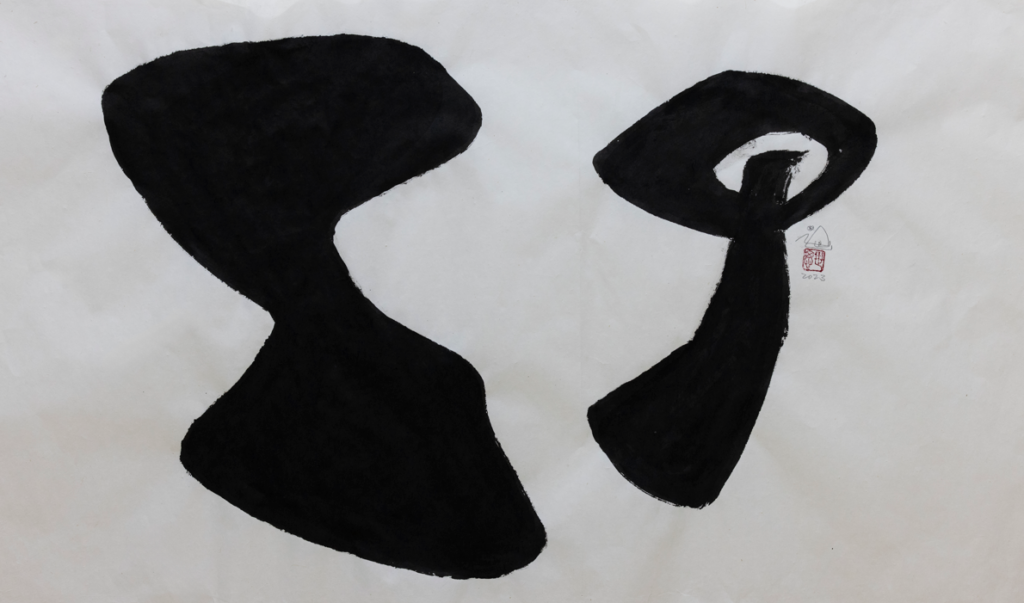
그렇기에 베르너 사세는 쓴소리도 마다하지 않는다. 아니, 정확하게 이야기하면 우리가 애써 모른 척 혹은 치부해버렸던 객관적 사실에 대해 직언한다.
That is why Werner Sasse does not shy away from speaking his mind. To be more precise, he speaks his mind about objective facts that we have tried to ignore or brush aside.
“자기 문화를 그리 좋아하지도, 깊이 관심 갖지도 않으면 무작정 ‘한국이 최고’라고 우기기 때문이다. 이를 테면 한글이 세계 모든 언어의 발음을 표기할 수 있다고 주장하지만 사실이 아니다. 한국어의 발음만 제대로 표기할 수 있다.”
”If you don’t like your own culture or are not deeply interested in it, you just insist that ‘Korea is the best.’ For example, they claim that the Korean alphabet, Hangeul, can represent the pronunciation of all languages in the world, but that is not true. “I can only properly write the pronunciation of the Korean language.”
그가 집필한 <민낯이 예쁜 코리안>에 나온 한 구절이다. 베르너 사세는 한글이 우수하지 않다고 말하는 것이 아니다. 자신의 문화를 과잉으로 때로는 자신의 문화와 역사를 모르면서 무조건적 옹호하는 태도를 지적한 것이다. 이것은 베르너 사세가 역사와 문화를 대하는 태도가 어떠한 지를 느낄 수 있는 대목이다.
This is a passage from his book “Korean with a Beautiful Bare Face”. Werner Sasse is not saying that Hangul is not excellent. He is pointing out the attitude of unconditionally defending one’s culture and history, sometimes with an excess of it. This is a passage that gives us a glimpse into Werner Sasse’s attitude towards history and culture.
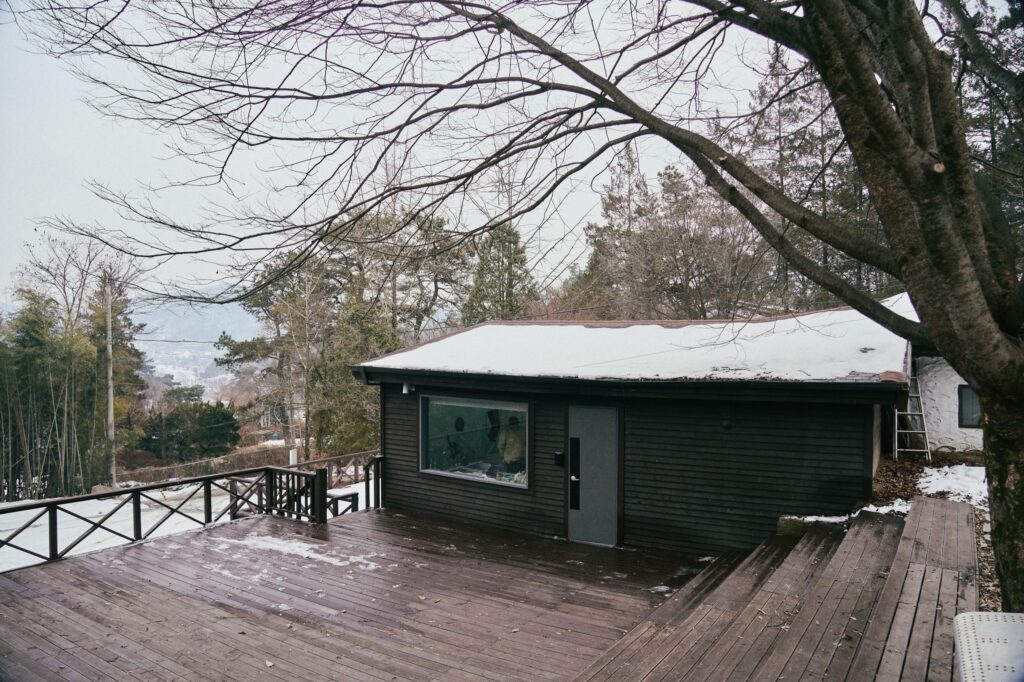


#정체성
한국에 사는 세계인
#Identity
A global citizen living in Korea
“저는 백인이고, 독일에서 왔고, 학자이며 화가입니다. 그래서 제가 한국 문화에 관심을 갖는 것을 신기해 할 필요가 없어요. 저는 한국에 사는 세계인이에요.”
한국에서 사는 독일인이고, 30년을 넘게 살았으니, 제2의 한국인이라는 소리를 종종 듣곤 하지만 베르너 사세는 한국에서 사는 세계인이라고 답한다. 서양의 문물을 사용하면서 동양적인 사고방식을 취한다고 동양인이라고 말하는 것 자체가 이제는 의미가 없다는 이야기다.
“나는 독일에서 태어났고, 내 사고방식도 독일식이지만 한국에서 오래 살다 보니 한국적 사고방식도 갖게 되었습니다. 그렇기에 전 세계인인 거죠.”
그의 사고는 그림의 정체성에도 그대로 투영된다. 외국인이 수묵화를 그리는 것이 다채롭다고 말하는 사람들에게 그는 진지하게 이야기한다.
“사람들은 이건 서양화, 이건 동양화라고 말을 해요. 학창시절부터 그렇게 배운 탓이죠. 전 그것이 고정관념이라고 생각해요. 그리는 방식이 다를 뿐 둘 다 그림이라는 통합적인 사고가 필요합니다. 이러한 사고가 바탕이 되었을 때 새롭게 해석할 수 있는 힘이 생길 수 있다고 생각합니다. 형식, 피사체 모두 중요하지 않죠. 그림이라는 동일한 정체성만 있을 뿐이에요.”
그의 말을 듣고 있자니 처음 만났을 때 반갑게 인사하던 베르나 사세가 떠올랐다. ‘안녕하세요’라며 특유의 외국인 억양이 묻어났던 그는 한국에서 오래 살아온 시간만큼 한국어가 유창했지만 여전히 한국의 발음이 명확히 들리지 않을 때도 많았다. 그의 말처럼 그것은 중요하지 않다. 오히려 모든 것을 분리하고, 나와 다르다고 생각하기에 실타래처럼 얽히고설키어 복잡다단해진 세상이 된 것은 아닐까. 그의 이야기를 듣다 보면 독일인이 수묵화를 한다는 게 생경한 일이 아니게 받아들여진다.
“I am white, from Germany, a scholar and a painter. So there is no need to be surprised that I am interested in Korean culture. I am a global citizen living in Korea.”
Werner Sasse is a German living in Korea and has lived here for more than 30 years, so he is often called a second Korean, but Werner Sasse says he is a global citizen living in Korea. This is to say that it is no longer meaningful to call someone an Oriental just because they use Western culture while adopting an eastern way of thinking.
“I was born in Germany, and my way of thinking is also German, but I have also acquired a Korean way of thinking after living in Korea for a long time. That is why I am a global citizen.”
His way of thinking is also reflected in the identity of his paintings. He talks seriously to people who say that it is colorful for foreigners to paint ink paintings.
“People say this is Western art, this is Eastern art. It’s because they’ve been taught that since they were students. I think that’s a stereotype. They just have different ways of drawing, but both require an integrated approach to painting. I think that when this approach is the foundation, it can give us the power to interpret in new ways. Form and subject matter are not important. There is only the same identity of painting.”
As I listened to him, I was reminded of Werner Sasse, who greeted me warmly when we first met. He said, “Hello,” with a distinctive foreign accent, and although he was fluent in Korean, as he had lived in Korea for a long time, there were still many times when I could not clearly hear his pronunciation. As he said, it does not matter. On the contrary, I think that the world has become more complicated and tangled because everything is separated and considered different from me. As I listen to his story, I come to accept that it is not strange for a German to paint in ink.

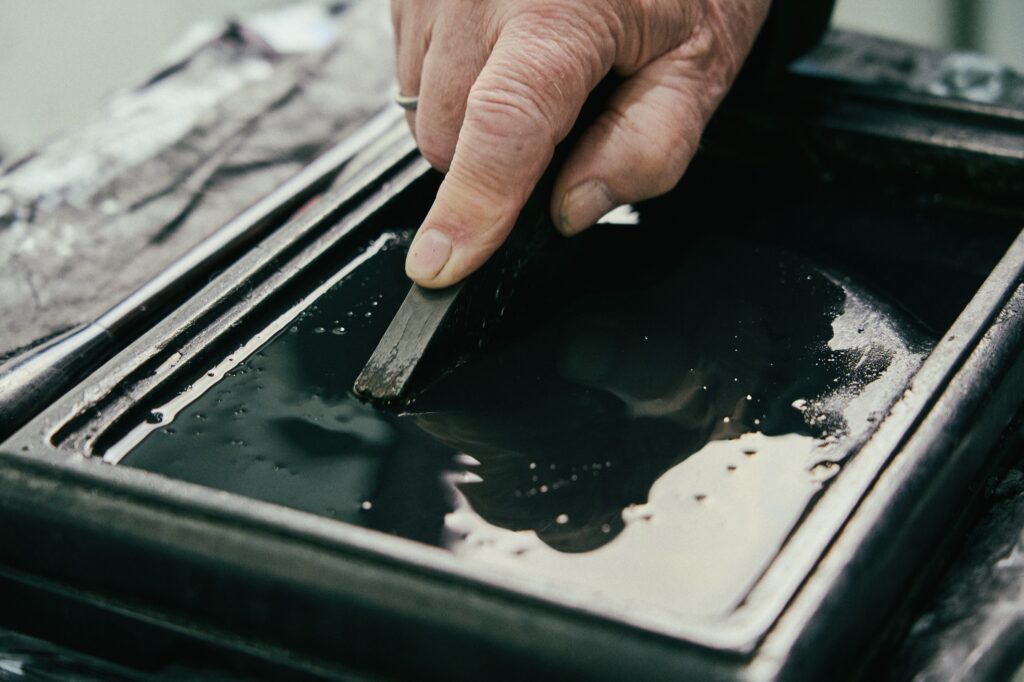

#수묵화
나의 작품은 무제
#Sumukwa (Ink Painting)
My work is untitled
우리는 사회적·경제적으로 바쁜 시대에 살아가고 있다. 정신없이 삶의 속도를 따라가기에 바쁘니 우리가 어디쯤 와 있는지 인식할 겨를이 없다. 그 속에서 ‘나를 좀 바라보세요!’라는 말을 사람들에게 인식시키고 각인시키기 위해서는 더 명료하게, 더 강렬하게 더 화려하게, 더 완성적으로 포장해야 한다. 한 번의 포장으로 어림없다. 겹겹이 포장을 해서 세상 사람들에게 선보여야 한다. 하지만 베르나 사세는 미술은 그래서는 안 된다고 한다. 미술은 답을 주는 것이 아니라 질문을 던지는 것이라고.
“제 작품은 모두 제목이 없어요. ‘무제’이죠. 그림을 보고 오늘은 이렇게 생각했는데 내일은 또 다르게 생각할 수 있도록 관객에게 여백의 시간을 주어야 합니다. 그림은 화가가 그리기에 화가가 의도하는 바가 있을지 몰라도 그 의도를 관객에게 의미를 부여하거나 정답을 알려줘서는 안 돼요. 관객이 스스로 의미를 찾도록 다양한 해석이 열려 있어야 해요. 그래서 제 작품의 제목은 무제입니다.”
베르너 사세다운 이야기다. 앞서 이야기한 정체성의 가치와도 일맥상통한다. 그래서 그는 작품을 그릴 때도 어떤 것을 담고자 하는 의도나 계획이 없다. 그저 붓이 가는 대로 맡겨둔다. 붓의 흐름에 맡긴 자유로운 화풍이라고 할 수 있겠다. 물론 한국 동양화의 정석을 따른 작품은 아니다. 선보다는 직선으로 때로는 원보다 사각형에 가까운 형태가 펼쳐져 있다. 하지만 자세히 들여다보면 수묵화가 맞다. 먹의 농도에 따라 번짐이 담겨 있으니 말이다.
“그림을 그리면서 붓의 흐름대로 따라가면서 저와 대화하죠. 대화하면서 붓이 가는 대로 따라가고, 혹은 내 의견대로 다른 방향으로도 가보고. 많은 상상을 할 수 있는 그 시간이 행복하죠.”
We are living in a time of social and economic busyness. We are so busy keeping up with the pace of life that we have no time to recognize where we are. In such a situation, in order to make people recognize and remember the words “Look at me!” we must present ourselves more clearly, more intensely, more colorfully, and more completely. One packaging is not enough. You need to wrap it in layers and present it to the world. But Werner Sasse says that art should not be like that. Art is not about giving answers, but about asking questions.
“All of my works don’t have titles. They are untitled. I want to give the audience time to think, so that they can think differently tomorrow after seeing the painting today.” The artist may have an intention when he or she paints, but the intention should not be given meaning or given an answer to the audience. Various interpretations should be open to allow the audience to find their own meaning. That is why the title of my work is Untitled.
It is a story about Werner Sasse. It is also in line with the value of identity mentioned earlier. That is why he has no intention or plan when he paints. He just lets the brush go where it wants to go. It can be said that it is a free painting style that leaves the brush to the flow of the brush. Of course, it is not a work that follows the rules of Korean oriental painting. The lines are straight rather than curved, and the shapes are sometimes more square than circular. But if you look closely, you will see that it is an ink painting. The ink is applied in different thicknesses.
“As I paint, I follow the flow of the brush and it talks to me. I follow the brush as it talks to me, or I go in a different direction based on my own ideas. I enjoy that time when I can imagine a lot.”
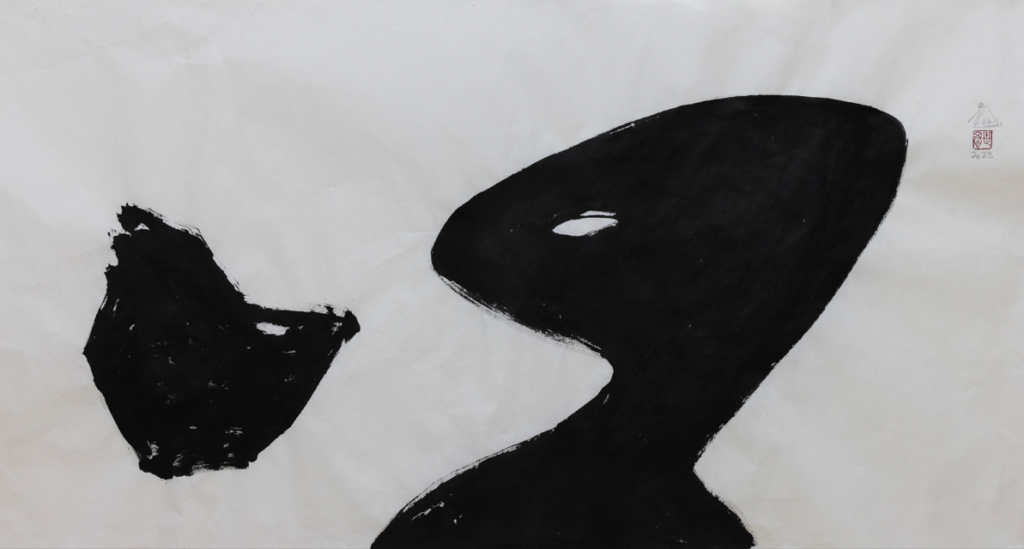
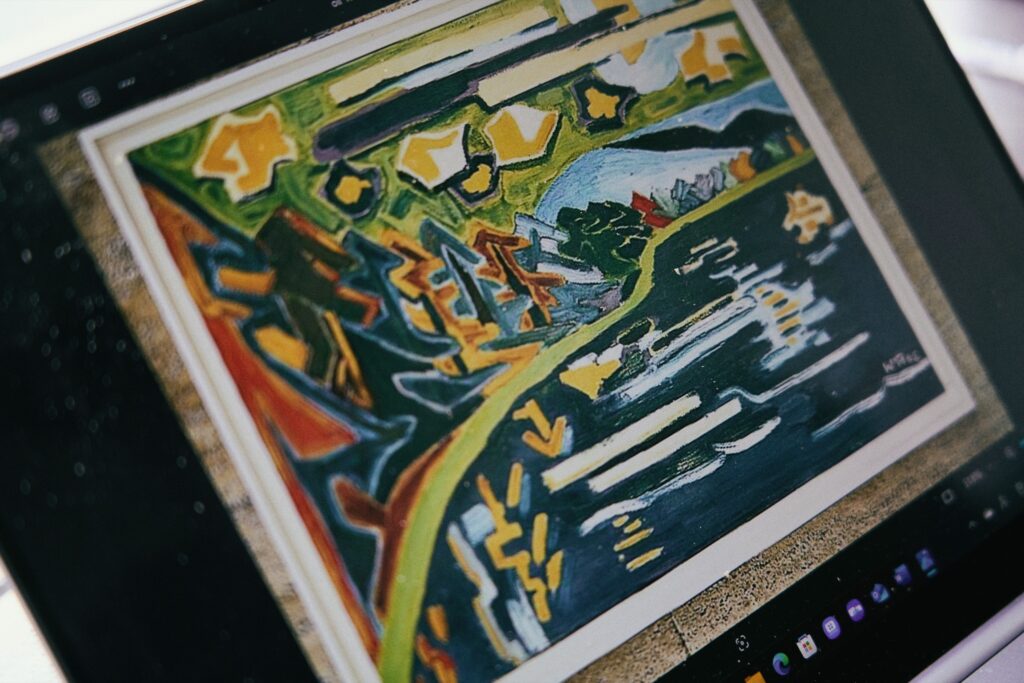
#지속성
먹에서 자라는 생명
#Sustainability
Life growing in the soil
베르너 사세는 수묵화를 배우지는 않았다. 하지만 그는 고등학교 때부터 미술에 관심을 가지고 유화를 그렸다. 그의 논리대로라면 그림을 그려온 이기에 수묵화가 그에게 낯선 작업은 아니었을 터.
“고등학교 미술에 관심을 가지게 되면서 유화를 그렸어요. 미술로 대학을 진학할 생각이었는데, 아버지의 반대로 할 수 없었어요. 하지만 이렇게 다시 그림을 하니, 꿈을 이룬 셈이죠.”
계속해서 수묵화 작업을 하는 이유에 대해 물으니, 화선지 위에 춤추는 먹의 번짐이 자라나는 생명이라는 생각이 든다고. 제주도에 살던 시절 화강암에서 느껴지던 그 힘이 먹에서 발현되고 있다고 말한다. 올해 84세. 그만 쉬어도 누가 이상하게 생각할 사람이 없는 나이지만 여전히 먹에서 자라는 생명력이 단단하다.
“제 공간을 보시면 아시겠지만 노트북이 있는 공간은 한국학 연구실이며, 붓과 먹이 있는 공간은 그림을 그리는 작업실이죠. 계속해서 한국학을 연구하고, 수묵화를 그릴 거예요. 시간을 정해놓지 않고 제가 할 수 있을 때까지 해 나가는 거죠. 독일 사람과 한국 사람이 삶을 대하는 태도의 가장 큰 다른 점을 꼽자면 ‘오늘’과 ‘내일’을 방점을 둔다는 점이 차이죠. 그래서 저는 한국에서 사는 세계인으로 오늘을 살아가는 데 전념을 다하고, 내일을 위한 오늘을 더욱 충실히 살아갈 겁니다. (웃음)”
Werner Sasse did not learn ink painting. However, he has been interested in art since high school and has painted in oil. According to his logic, ink painting would not have been a strange task for him since he has been painting.
“I started to take an interest in high school art and started painting oil paintings. I was planning to go to college for art, but I couldn’t do it because of my father’s opposition. But now that I’m painting again, I’ve achieved my dream.”
When asked why he continues to work with ink and wash, he said that he feels that the spreading of ink on the paper is like the growth of life. He says that the power he felt in the granite when he lived in Jeju is now expressed in the ink. He is 84 years old this year. He is old enough to rest and no one would think anything of it, but he still has a strong vitality that grows in his ink.
“As you can see from my space, the area with the laptop is the Korean Studies Lab, and the area with the brush and ink is the studio where I paint. I will continue to study Korean Studies and paint ink paintings. I don’t set a time limit, I just keep going until I’m done. The biggest difference between the attitude of Germans and Koreans towards life is that they place emphasis on ‘today’ and ‘tomorrow’. So I, as a global citizen living in Korea, will devote myself to living in the present and live more faithfully today for tomorrow. (Laughs)”
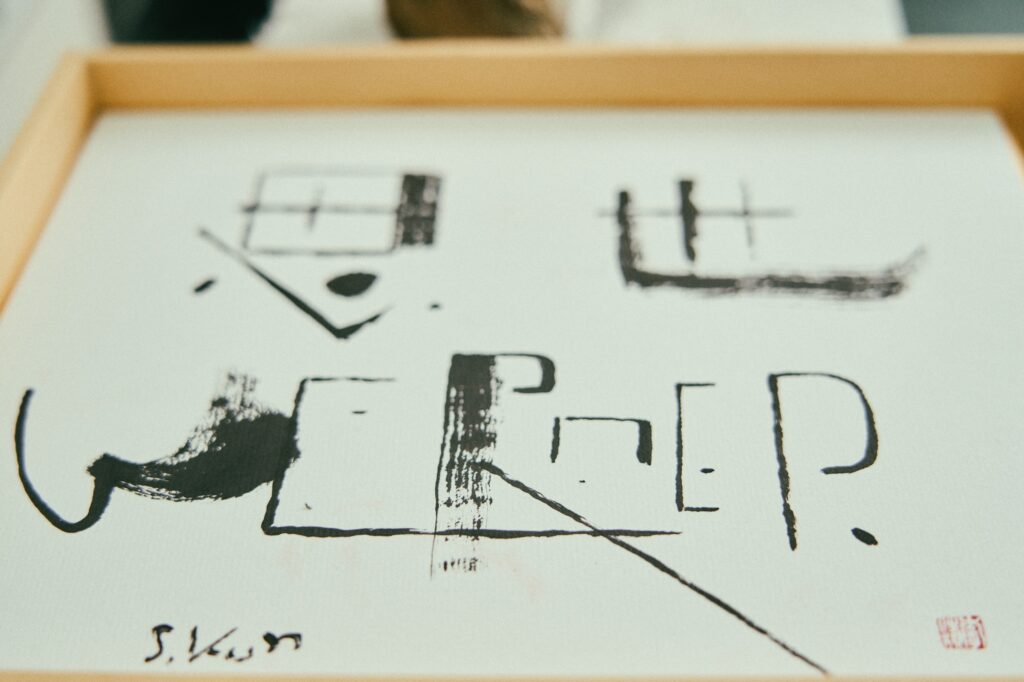
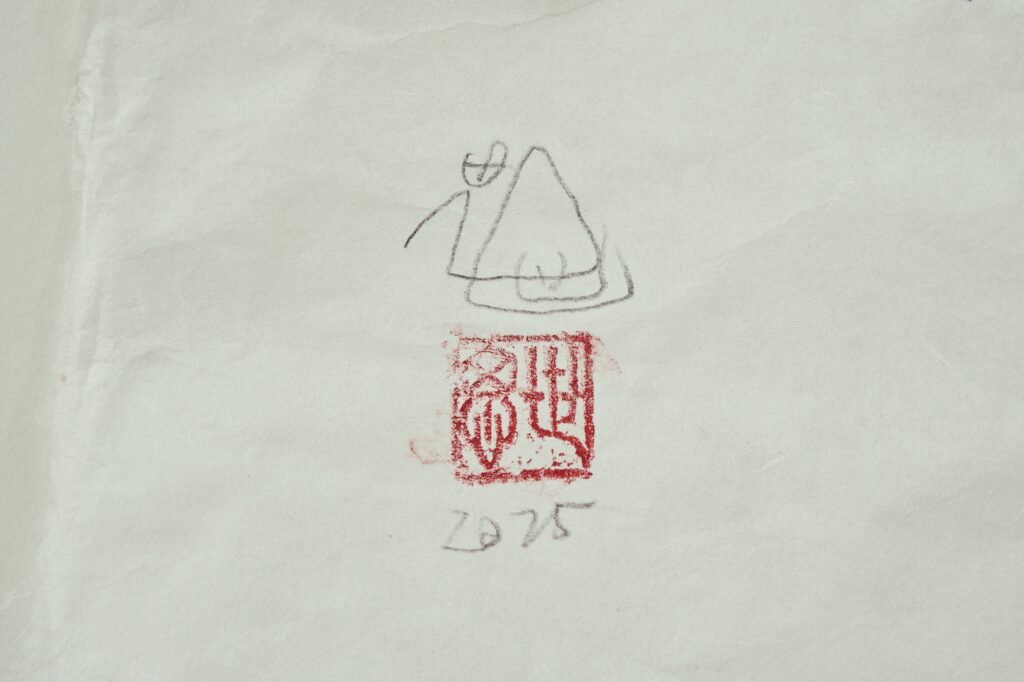
Epilogue
작품 구석에 새긴 낙관이 유독 눈에 띈다. 생각 사(思), 세상 세(世)를 조합한 한자 이름 사세(思世), ‘세상을 생각한다’라는 의미이다. 이 낙관 위에 사인도 함께 넣는다. ‘한국에서 살아가는 세계인’라고 자신을 말하는 베르너 사세의 의지를 엿볼 수 있는 대목이다. 세상을 관조하며, 객관적으로 읽고 생각하는 베르너 사세의 태도를 보고 있자면 다소 한국인에게 불편한 이야기일지라도 한국인 앞에서 당당하게 말하는 그 진심이 무엇인지 느낄 수 있었다. 너무 익숙하면 쉬이 지나치기 마련이다. 한국인이기에 익숙한 나머지 돌아보지 않았던 것일지도 모른다. 본질을 바라보라는 그의 말은 애써 포장하는 동시대에 살아가는 우리에게 울림을 주었다. 먹의 번짐이 화선지에 스며들 듯, 베르너 사세가 전하는 이야기들이 찬찬히 스며드는 시간이었다.
Epilogue
The seal engraved in the corner of the work stands out. The Chinese characters for thought (思) and world (世) are combined to form the name Sasse (思世), which means “thinking about the world.” The signature is also placed above this seal. This is a glimpse into Werner Sasse’s will to describe himself as a “global citizen living in Korea.” When I looked at Werner Sasse’s attitude of contemplating the world and reading and thinking objectively, I could feel what his sincerity was, which he spoke boldly in front of Koreans even if it was a story that was somewhat uncomfortable for Koreans. If something is too familiar, it is easy to pass by. It may be that Koreans are so used to it that they have not looked back. His words to look at the essence resonated with us, who live in an age of effortful packaging. It was a time when the stories told by Werner Sasse slowly seeped into the paper, as if the ink spread into the paper.
About 베르너 사세
1941년 독일 프랑크 푸르트 암 마인(Frankfurt am Main)에서 태어난 베르너 사세는 독일 보훔(Bochum) 대학에서 최초로 한국학을 전공하고 박사 학위를 받았으며, 모교에서 교수가 된 후에 한국학을 확장한 한국학 교수이다. 그리고 1992년에 함부르크(Hamburg)에서도 한국학과를 설립하고 교수 생활을 해왔다. 세종대왕이 한글로 만든 노래인 <월인천강지곡>을 독일어로 번역하고, 한국의 한문 고서인 <동국세시기>를 영어로 번역하는 등 한국 문화의 세계화에 힘썼으며, 유럽한국학회(Association for Korean Studies in Europe)의 회장직을 맡아 한국의 전통문화를 유럽에 전하는데 크게 공헌했다. 은퇴 후에는 한국에 정착해 전남대 5.18 연구소 객원교수, 한양대학교 문화인류학과 석좌교수 등을 역임하며 연구활동을 활발히 해 왔습니다. 화가로도 활동 중인 베르너 사세 교수는 한국의 전통 예술 양식에 서양식 화풍을 더한 독특한 그림세계로 인사아트프라자 갤러리 《베르너 사세》 초대전, 갤러리 모나리자 산촌 《베르너 사세》 초대전 등 활발한 작품 활동을 한다.
About Werner Sasse
Born in Frankfurt am Main, Germany, in 1941, Werner Sasse was the first to major in Korean Studies at the University of Bochum in Germany and received a doctorate in the field. He became a professor at his alma mater and expanded the study of Korean Studies. He also founded the Department of Korean Studies at Hamburg University in 1992 and has been teaching there ever since. He worked hard to globalize Korean culture, such as translating “Wolin Cheongangjigok,” a song written in Hangeul by King Sejong the Great, into German, and translating “Dongguk Sesigi,” a Korean classical book of Chinese characters, into English. He also served as the president of the Association for Korean Studies in Europe and made a great contribution to introducing Korean traditional culture to Europe. After retiring, he settled in Korea and has been actively engaged in research activities as a visiting professor at the 5.18 Research Institute at Chonnam National University and a chair professor in the Department of Cultural Anthropology at Hanyang University. Professor Werner Sasse, who is also active as a painter, has a unique painting world that combines Western painting styles with traditional Korean art. He is actively engaged in his work, including the invitation to the Insa Art Plaza Gallery “Werner Sasse” and the invitation to the Gallery Monalisa Sanchon “Werner Sasse”.